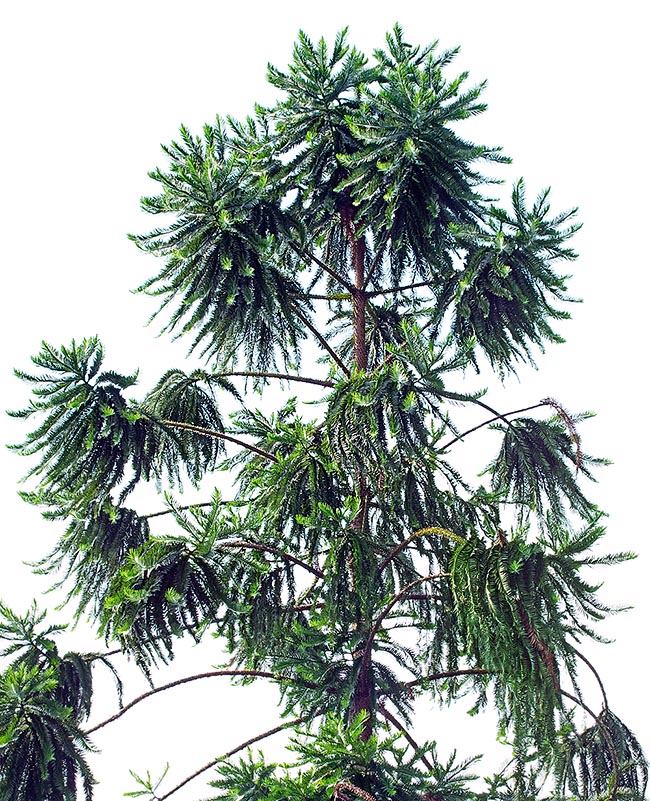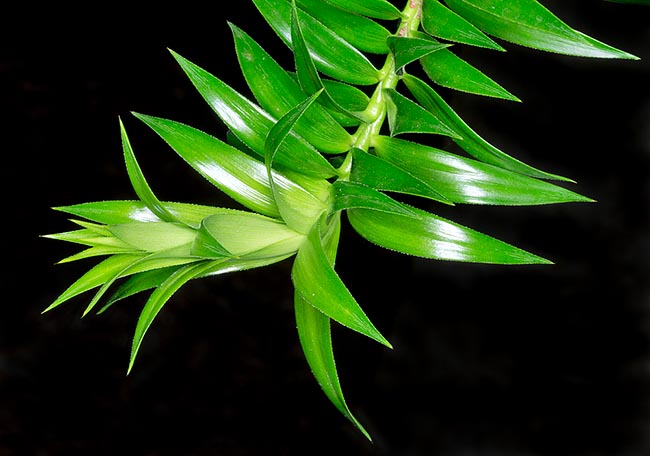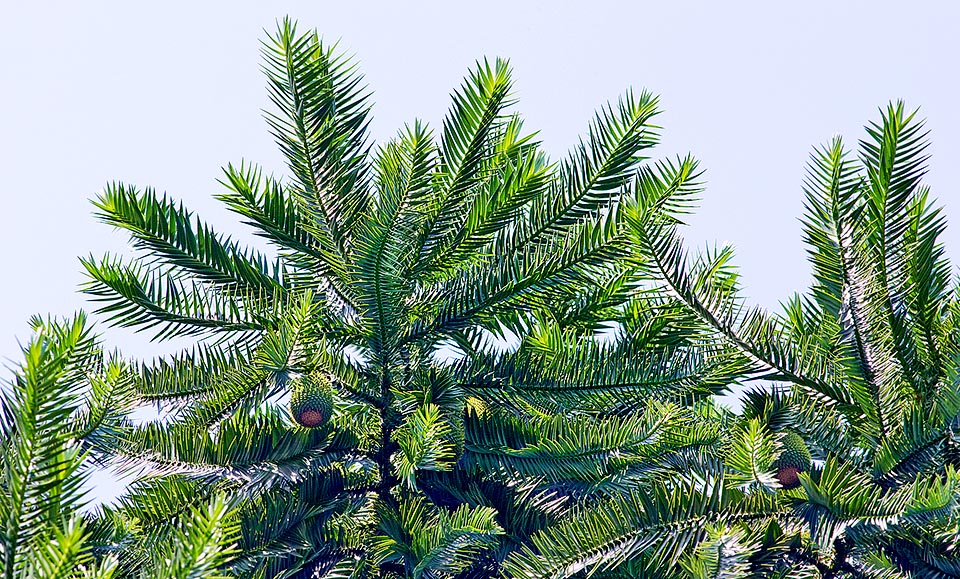Family : Araucariaceae

Text © Pietro Puccio

English translation by Mario Beltramini

Araucaria hunsteiini is native to the humid forests of Papua New Guinea where can be 90 m tall © Giuseppe Mazza
The species is native to Papua New Guinea where grows in the north-eastern part in the humid tropical forests, where it represents the emerging species, usually in the intermountain valleys between 500 and 2000 m of altitude, on mainly alluvial soils.
The name of the genus comes from that of a Chilean ethnic group, the Araucanos, in whose territories lives the first discovered species, the Araucaria araucana; the species is honoured to the German ornithologist and collector of plants, Carl Hunstein (1843-1888), its discoverer.
Common names: klinki pine (English); araucaria de Papouasie-Nouvelle-Guinée (French); araucária de Nova Guiné (Portuguese).
The Araucaria hunsteinii K.Schum. (1889) is an evergreen, exceptionally up to 90 m tall tree in the areas characterized by high rainfall, with erect cylindrical trunk, up to 2 m of diameter, with rough bark, resinous, of reddish brown colour, that flakes in large plates.
The main lateral branches, in number of 6-8 arranged in pseudo-virticils, are more or less horizontal, up to 6 m long, partially without leaves, with secondary branches, erect or drooping, grouped towards the extremity, provided of leaves. The leaves, sessile, have a certain dimorphism, in the young plants, till when 20 years old, are spirally arranged, lanceolate, flat, 3-9 cm long and 0,5-1,5 cm broad, in the adult plants they are spirally arranged, thickened and imbricate, triangular to lanceolate with pointed apex, flat, 3-15 cm long and 1-2 cm broad, of grey green or dark green colour.
Unisexual inflorescences on the same plant, the male cones, axillar, sessile, are arranged in groups of 2-6 in the lower mid of the top, initially erect, then pendulous, 10-25 cm long and 1-2,5 cm broad, with 8-10 pollen cells. The female cones, usually solitary, produced in the upper half of the top on short peduncle, are erect, obovoid to cylindrical, 15-25 cm long and of 12-14 cm of diameter, with cuneate bracts with pointed lateral wing and apex, about 5 cm long and 8 cm broad, and ovuliferous scale merged in the inner part.

The sessile leaves are spirally arranged, triangular to lanceolate, flat, 3-9 cm long © Giuseppe Mazza
The seeds are flattened, about 3 cm long and 0,8 cm broad with membranous wing about 2,5 cm broad; the interval between the blooming and the dissemination of seeds varies from 21 to 24 months.
It reproduces by seed, that has a low percentage of fertility and duration of germinability, few weeks if not duly preserved, with germination times of 1-7 weeks, and by apical cutting in sandy loam at the temperature of 20-22 °C.
Fast growing species, after the initial phase of settling, cultivable in the tropical and subtropical climate zones with high annual rainfall, its cultivation may be tried in the milder temperate ones, where values of temperature around the 0 °C are exceptional and short lasting occurrences.
It grows in acidic or neutral soils, mainly clayey, and stands also the poorly draining heavy ones where many other cultivations would not be possible.
It is extensively cultivated, especially in Papua New Guinea, for the wood of average density, easy to work, utilizable in the constructions, in cabinetry and especially in the plywood industry. Finally, are not to be underestimated its ornamental characteristics.

The female cones, usually solitary, produced in the upper half of the top on short peduncle, are obovoid to cylindrical, 15-25 cm long © Giuseppe Mazza
Synonyms Araucaria schumanniana Warb. (1900); Araucaria klinkii Lauterb. (1913); Araucaria hunsteinii var. klinkii (Lauterb.) Silba (1990); Titanodendron hunsteinii (K.Schum.) A.V.Bobrov & Melikyan (2006); Titanodendron klinkii (Lauterb.) A.V.Bobrov & Melikyan (2006); Titanodendron schumanniana (Warb.) A.V.Bobrov & Melikyan (2006); Araucaria hunsteinii subsp. klinkii (Lauterb.) Silba (2009).
→ To appreciate the biodiversity within the ARAUCARIACEAE family please click here.
